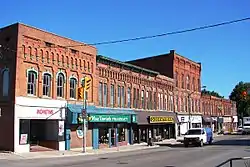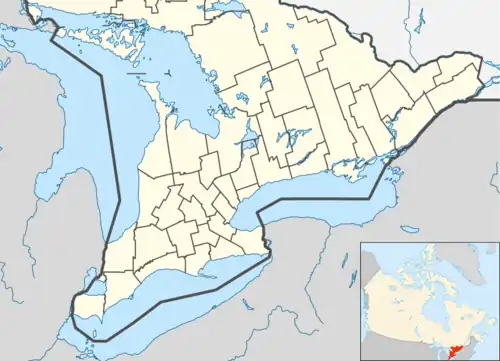Dresden | |
|---|---|
Community | |
 | |
| Motto(s): Discover Dresden: The Charm, The Beauty, The Lifestyle | |
 Dresden  Dresden | |
| Coordinates: 42°35′25″N 82°10′54″W / 42.59028°N 82.18167°W | |
| Country | Canada |
| Province | Ontario |
| Municipality | Chatham-Kent |
| Population | |
| • Total | 2,800 |
| Time zone | UTC−05:00 (EST) |
| • Summer (DST) | UTC−04:00 (EDT) |
| Forward sortation area | |
| Area code(s) | 519 and 226 |
| NTS Map | 040J09 |
| GNBC Code | FAZSG |
| Website | dresden |
Dresden is an agricultural community in southwestern Ontario, Canada, part of the municipality of Chatham-Kent. It is located on the Sydenham River. The community is named after Dresden, Germany. The major field crops in the area, by both acreage and production, are grain corn, soybean, and winter wheat.[1] The main horticultural crop is tomatoes, followed by sweet corn and carrots.[2] Dresden's post office was established in 1852.[3]
Dresden is best known as the home of Josiah Henson, an African-Canadian leader and minister whose life story was an inspiration for the novel Uncle Tom's Cabin. The Henson homestead is a historic site located near Dresden, owned and operated by the Ontario Heritage Trust.
An H chondrite-type meteorite fell near Dresden in 1939.[4]
History
Culture

An important terminus of the Underground Railroad's overland and maritime routes, Dresden is near the former Dawn Settlement, a community of refugees from slavery. Dawn grew up around the British-American Institute, a vocational school whose principal founder, in 1842, was Josiah Henson. The grounds of the Settlement are now the site of the Josiah Henson Museum of African-Canadian History (formerly Uncle Tom's Cabin Historic Site),[5][6] which lies just outside Dresden's borders at the corner of Park St. and Freedom Road (formerly Uncle Tom's Road).
The town and its organizations (including the Horticultural Society, Rotary and IODE) have striven to develop Dresden's historical legacy and its natural features, particularly the Sydenham River.[7] Since the 100-year flood of 1968,[8] Dresden's floodplain has been improved with the addition of landscaped parklands, an arboretum featuring the area's original and diverse Carolinian forest flora,[9] and the 5.8 km Trillium Trail, which includes a historical walk section. The trailhead and interpretive centre is on St. George Street, near the bridge over the Sydenham River.[10] The 2.4 km historical walk has numerous plaques describing over 50 sites connected to key figures and industries that helped shape the town.[11] It celebrates a history that, while typical of rural settlements in the region, is unique to Dresden, given its strong ties to the Underground Railroad.
Dresden was once home to not only Rev. Josiah Henson, famous because of his association with the title character of Harriett Beecher Stowe's Uncle Tom's Cabin, but a variety of prominent figures from the Underground Railroad period. A recent discovery through the Trillium Trail Project, verified by research done in partnership with the Promised Land Project,[12][13] is that large sections of the original town site were owned between 1853 and 1873 by William Whipper, a prominent member of the William Still Underground Railroad network. Several houses from this period still survive.[14] The local Catherine McVean Chapter of the IODE offers historical tours to visitors who wish to know more of the town's history. The town is also home to civil rights actions both in the 1850s and 1950s, and this and other historical events are commemorated on various Ontario Heritage historical plaques in the town.
The Sydenham River, which flows through the town, is known for its many species of fish and mussels, and, in its watershed, semi-aquatic amphibians, turtles, snakes, and dragonflies. However, a number of these species are at risk.[15] The Trillium Trail, particularly in the downtown arboretum area, has informative signage about the rare plants and animals inhabiting the Sydenham and its watershed.
The town features a number of special events each year, including a Show and Shine for classic autos, and weekly concerts on Thursday evenings during the summer months at Rotary Park.
Harness races are held at the Dresden Raceway in the summer. The Raceway has a ½-mile oval track with a grandstand, and offers a range of betting and dining options. The track is also used to train pacer and trotter horses, and for occasional demolition derbies and truck and tractor pulls.[16] The Dresden Fair, with an exhibition, a cattle show, and a midway, takes place over three successive days towards the end of July each year.[17] It has been held, in one form or another, for nearly 150 years.[18]
The downtown area runs for about 3 blocks, with stores and businesses that serve the local and surrounding community and tourists. For a bit of colour, the streets are lined with planters courtesy of the Dresden Horticultural Society and many volunteers. In October, just before Halloween, there are cornstalk and scarecrow decorations on the lampposts. There is a grocery store, a drug store, jewellery and gifts, photography studio, a hardware store, post office, automotive supplies, dentist, doctors, optometrist, a gym, legal advice, and more. A medical facility, operated by the Chatham-Kent Family Health Team, opened in 2012.[19]
In 1871, 72% of Dresden's 700 residents were Black Canadians. This number has steadily declined over the years. By 1949, Dresden was 17% Black.[20] The proportion of Black residents dropped to 11% in 2001, and reached a historic low of 5.5% in 2016.[21]
The North Star: Finding Black Mecca, a 2021 film about Chatham-Kent's black communities and history is partly filmed in Dresden.[22][23]
Human rights history
Hugh Burnett returned to his home town of Dresden, after serving his country in World War II. However, he was not served in some restaurants because he was black. So, in 1948, he and other African Canadians founded the National Unity Association. They collected 115 names on a petition to end discrimination. This resulted in a referendum in Dresden which asked "Do you approve of the council passing a bylaw licensing restaurants in Dresden and restraining the owner or owners from refusing service regardless of race, colour or creed?" 108 voted that restaurant owners should serve everyone. 517 voted against.[24] The vote in favour, was roughly equal to the proportion of African Canadians in the town - indicating nearly all European (white) residents voted against ending discrimination in Dresden.
In 1954, Burnett was part of a delegation to Ontario Premier Leslie Frost and the cabinet. Soon after that, the Ontario Fair Accommodation Practices Act passed. It stated that "no one can deny to any person or class of persons the accommodation, services or facilities usually available to members of the public."[25]
However, some restaurants and barber shops still refused to serve African Canadians. Justice William F. Schwenger investigated the complaints as a one-man commission. On the basis of his recommendations, Charles Daley, the minister of labour, declined to prosecute two Dresden restaurant owners who had refused to serve black people. Daley said "I understand these people will in future obey the law, although I have not spoken directly to them".[26]
On October 29, 1954, Hugh Burnett, Bromley Armstrong and Ruth Lor Malloy went to Morley McKay's restaurant with a reporter. They were denied service.[27] Mr. McKay was the first person to be charged under the Act.[28] After a long legal battle, Mr. McKay opened his restaurant to everyone.
In 1954, the conflicting attitudes of white and black Dresden residents over the issue were recorded in The Dresden Story, a 30-minute National Film Board documentary.[29]
On July 31, 2010, a plaque was installed in Dresden that honoured Hugh Burnett and the National Unity Association. It reads:
Hugh Burnett and the National Unity Association Between 1948 and 1956, the National Unity Association (NUA) of Chatham, Dresden and North Buxton, under the leadership of Hugh R. Burnett, waged a campaign for racial equality and social justice. Their efforts led to the passage of Ontario’s Fair Employment Practices Act (1951) and Fair Accommodation Practices Act (1954), and laid the groundwork for subsequent human rights legislation in Ontario and across Canada. Traditional Anglo-Canadian rights, such as freedom of association and freedom of commerce, had historically been interpreted to permit discrimination on grounds of race, colour or creed in providing services to the public. The NUA inspired recognition of freedom from discrimination as a fundamental principle; this led to a revolutionary change to the course of Canadian law and Canadian history. Hugh Burnett and the NUA were early pioneers in the articulation of equality rights for all Canadians, now constitutionally inscribed in the Charter of Rights and Freedoms.[24]
Climate and geography
The climate is mild, being classified as humid continental (Köppen climate classification Dfb) that closely borders on the Dfa climate type. Summer days can be hot and humid with a July high of 27.1 °C (80.8 °F) and a low of 15.7 °C (60.3 °F) . In an average summer, temperatures exceed or reach 30 °C (86.0 °F) on 16 days per year.[30] Winters are cold with a January high of −2.3 °C (27.9 °F) and a low of −9.0 °C (15.8 °F). Occasionally, mild spells of weather can make the temperature exceed 10 °C (50.0 °F) for 1 or 2 days while arctic air masses from the north can bring temperatures below −20 °C (−4.0 °F) for 1–3 days during winter.[30] Dresden is not located in the snowbelt region which begins near London, Ontario, causing winter precipitation to be generally low and snow cover to be intermittent throughout the season. The average annual snowfall is only 84.6 centimetres (33.3 in).
| Climate data for Dresden, Ontario (1981–2010) | |||||||||||||
|---|---|---|---|---|---|---|---|---|---|---|---|---|---|
| Month | Jan | Feb | Mar | Apr | May | Jun | Jul | Aug | Sep | Oct | Nov | Dec | Year |
| Record high °C (°F) | 15.5 (59.9) |
15.0 (59.0) |
24.4 (75.9) |
30.0 (86.0) |
35.5 (95.9) |
38.0 (100.4) |
36.5 (97.7) |
36.5 (97.7) |
34.4 (93.9) |
30.6 (87.1) |
22.8 (73.0) |
17.8 (64.0) |
38.0 (100.4) |
| Average high °C (°F) | −2.2 (28.0) |
−0.9 (30.4) |
4.8 (40.6) |
12.2 (54.0) |
19.6 (67.3) |
24.7 (76.5) |
27.1 (80.8) |
25.9 (78.6) |
21.4 (70.5) |
14.6 (58.3) |
6.9 (44.4) |
1.1 (34.0) |
12.9 (55.2) |
| Daily mean °C (°F) | −5.5 (22.1) |
−4.4 (24.1) |
0.7 (33.3) |
7.3 (45.1) |
13.9 (57.0) |
19.1 (66.4) |
21.4 (70.5) |
20.3 (68.5) |
16.0 (60.8) |
10.0 (50.0) |
3.5 (38.3) |
−1.7 (28.9) |
8.4 (47.1) |
| Average low °C (°F) | −8.8 (16.2) |
−7.9 (17.8) |
−3.4 (25.9) |
2.4 (36.3) |
8.1 (46.6) |
13.4 (56.1) |
15.8 (60.4) |
14.7 (58.5) |
10.6 (51.1) |
5.3 (41.5) |
0.2 (32.4) |
−4.5 (23.9) |
3.8 (38.8) |
| Record low °C (°F) | −30.0 (−22.0) |
−25.6 (−14.1) |
−22.2 (−8.0) |
−13.0 (8.6) |
−3.5 (25.7) |
0.0 (32.0) |
5.5 (41.9) |
0.0 (32.0) |
−3.0 (26.6) |
−8.0 (17.6) |
−12.0 (10.4) |
−25.0 (−13.0) |
−30.0 (−22.0) |
| Average precipitation mm (inches) | 51.5 (2.03) |
48.5 (1.91) |
55.4 (2.18) |
79.5 (3.13) |
76.5 (3.01) |
90.2 (3.55) |
80.4 (3.17) |
80.2 (3.16) |
107.5 (4.23) |
68.7 (2.70) |
84.8 (3.34) |
65.6 (2.58) |
888.9 (35.00) |
| Average rainfall mm (inches) | 25.1 (0.99) |
25.2 (0.99) |
41.0 (1.61) |
74.4 (2.93) |
76.5 (3.01) |
90.2 (3.55) |
80.4 (3.17) |
80.2 (3.16) |
107.5 (4.23) |
68.5 (2.70) |
81.5 (3.21) |
45.4 (1.79) |
796.0 (31.34) |
| Average snowfall cm (inches) | 26.5 (10.4) |
23.3 (9.2) |
14.3 (5.6) |
5.2 (2.0) |
0.0 (0.0) |
0.0 (0.0) |
0.0 (0.0) |
0.0 (0.0) |
0.0 (0.0) |
0.2 (0.1) |
3.3 (1.3) |
20.2 (8.0) |
93.0 (36.6) |
| Average precipitation days (≥ 0.2 mm) | 11.5 | 9.8 | 11.2 | 13.7 | 10.8 | 9.5 | 10.1 | 10.2 | 11.5 | 11.1 | 12.1 | 13.4 | 134.7 |
| Average rainy days (≥ 0.2 mm) | 4.4 | 4.4 | 8.1 | 12.9 | 10.8 | 9.5 | 10.1 | 10.2 | 11.5 | 11.1 | 11.0 | 7.9 | 111.8 |
| Average snowy days (≥ 0.2 cm) | 7.5 | 5.9 | 3.9 | 1.3 | 0.0 | 0.0 | 0.0 | 0.0 | 0.0 | 0.06 | 1.2 | 7.2 | 27.0 |
| Source: Environment Canada[30] | |||||||||||||
Education
Dresden has one secondary school, Lambton-Kent Composite School (LKCS) and one elementary school, Dresden Area Central School (DACS), that serve Dresden and the surrounding communities.
Industry and small business
Dresden features a number of small businesses ranging from gas stations to specialty retail stores and service providers. Since 1947, Dresden has hosted ConAgra Foods' tomato processing plant, a major local employer.[31] In September 2023, the parent company announced a significant upgrade and expansion of the facility.[32] Other firms based in Dresden include Martinrea Metallic Canada Inc., part of Martinrea International, an auto parts manufacturer; Richkote Metal Finishing Inc.; Waste Wood Disposal Ltd.; and MPT Inc., a provider of automated manufacturing systems.
In 2007, Dresden celebrated the 125th year since its founding.
References
- ↑ "Ontario field crop area and production estimates by county". Ministry of Agriculture, Food and Rural Affairs. Government of Ontario. 31 May 2023.
- ↑ "Ontario fruit and vegetable production and farm value by county". Ministry of Agriculture, Food and Rural Affairs. Government of Ontario. 9 December 2022.
- ↑ Hamilton, William (1978). The Macmillan Book of Canadian Place Names. Toronto: Macmillan. p. 145. ISBN 0-7715-9754-1.
- ↑ Plotkin, Howard (April 2006). "The Dresden (Ontario) H6 Chondrite, Part I: Fireball Observations, Recovery and Sale, Field Searches, and Tribute". Journal of the Royal Astronomical Society of Canada. 100 (2): 64–72. Bibcode:2006JRASC.100...64P. Retrieved 11 November 2023.
- ↑ Josiah Henson Museum of African-Canadian History. "Reclaiming Josiah Henson". Ontario Heritage Trust. Retrieved 25 November 2023.
- ↑ Wang, Kelly (30 July 2022). "New name for Uncle Tom's Cabin Historic Site to reclaim legacy of Josiah Henson". globalnews.ca. Corus Entertainment. Retrieved 27 October 2023.
- ↑ Blake, Jim (21 May 2014). "IODE continues to live in deeds". The Chatham Voice. Retrieved 18 November 2023.
- ↑ "Floods force 4,000 from homes in Kent county". Toronto Daily Star. February 4, 1968. pp. 1–2.
- ↑ "Carolinian Forest Flora". Carolinian Canada. Retrieved 25 November 2023.
- ↑ "Dresden Trillium Trail". Ontario Trails Council. Retrieved 2 December 2023.
- ↑ "Take a Step Back in Time along the Trillium Historical Walk" (PDF). Town of Dresden, Ontario (brochure). 2018. Retrieved 2 December 2023.
- ↑ de B'béri, Boulou Ebanda; Reid-Maroney, Nina; Wright, Handel Kashope, eds. (2014). The Promised Land: History and Historiography of the Black Experience in Chatham-Kent's Settlements and Beyond. Toronto: University of Toronto Press. ISBN 9781442667464.
- ↑ Government of Canada, Social Sciences and Humanities Research Council (SSHRC) (28 February 2013). "Beyond the Underground Railroad: The Promised Land Project reveals forgotten Black History". Retrieved 25 November 2023.
- ↑ Bernard, Jackie (host – program assistant at Josiah Henson Museum of African-Canadian History); Carter, Marie (local historian) (3 March 2022). "Josiah Henson and McInnes Family Friendship" (video). Discovering Dawn. Episode 4. Ontario Heritage Trust. 0:40 minutes in. Retrieved 3 December 2023 – via YouTube.
We have some wonderful old Victorian-style homes that are still very well maintained here.
- ↑ "Species at Risk in the Sydenham". St. Clair Region Conservation Authority — The Sydenham River Watershed. Retrieved 2 December 2023.
- ↑ "Dresden Raceway". Dresden Raceway. Retrieved 3 December 2023.
- ↑ "Dresden Fair". Dresden Agricultural Society. Retrieved 3 December 2023.
- ↑ Burns, Helen Watson (1975). ""Over The Years" of the Dresden Agricultural Society : A history of the Camden and Dresden Agricultural Societies from its inception in 1875 to the present day" (PDF). Chatham-Kent Public Library Digital Collections. Dresden, Ontario: Dresden Agricultural Society. Retrieved 3 December 2023.
- ↑ "Dresden healthcare on the mend!". Chatham-Kent Family Health Team. Retrieved December 28, 2018.
- ↑ The Blacks in Canada : a history (2nd ed.). McGill-Queen's University Press. 1997. ISBN 0773516328.
- ↑ Government of Canada, Statistics Canada (8 February 2017). "Census Profile, 2016 Census - Dresden [Population centre], Ontario and Ontario [Province]". www12.statcan.gc.ca.
- ↑ "The North Star: Finding Black Mecca". IMDB. Retrieved 3 August 2020.
- ↑ Morrison, Tom (17 September 2019). "'The North Star' documentary being filmed in Chatham-Kent". Chatham This Week. Retrieved 3 August 2020.
- 1 2 "Hugh Burnett and the National Unity Association" (PDF). Ontario Heritage Trust. Archived from the original (PDF) on October 4, 2013.
- ↑ "Canadian Human Rights Commission". Archived from the original on 2013-10-05.
- ↑ "Won't Prosecute 2 Dresden Café Owners – Daley". Toronto Daily Star. October 20, 1954. p. 1.
- ↑ "Dresden's Color Bar Still Up, Rap Daley Failure To Apply Law" (Reprint). Toronto Daily Star. October 30, 1954. pp. 1–2. Retrieved 28 October 2023.
- ↑ "Amid sweeping change, a pivotal anniversary goes unremarked". Toronto Star. July 6, 2008.
- ↑ Watch The Dresden Story on the NFB website.
- 1 2 3 "Dresden, Ontario". Canadian Climate Normals 1981–2010. Environment Canada. 25 September 2013. Archived from the original on August 28, 2019. Retrieved August 28, 2019.
- ↑ Hill, Millar (27 June 2022). "Conagra celebrates 75 years of tomato processing in Dresden". CK News Today. Retrieved 25 November 2023.
- ↑ Branthôme, François-Xavier (13 October 2023). "Conagra Brands announces upgrades to tomato processing plant in Ontario". Tomato News. Retrieved 25 November 2023.